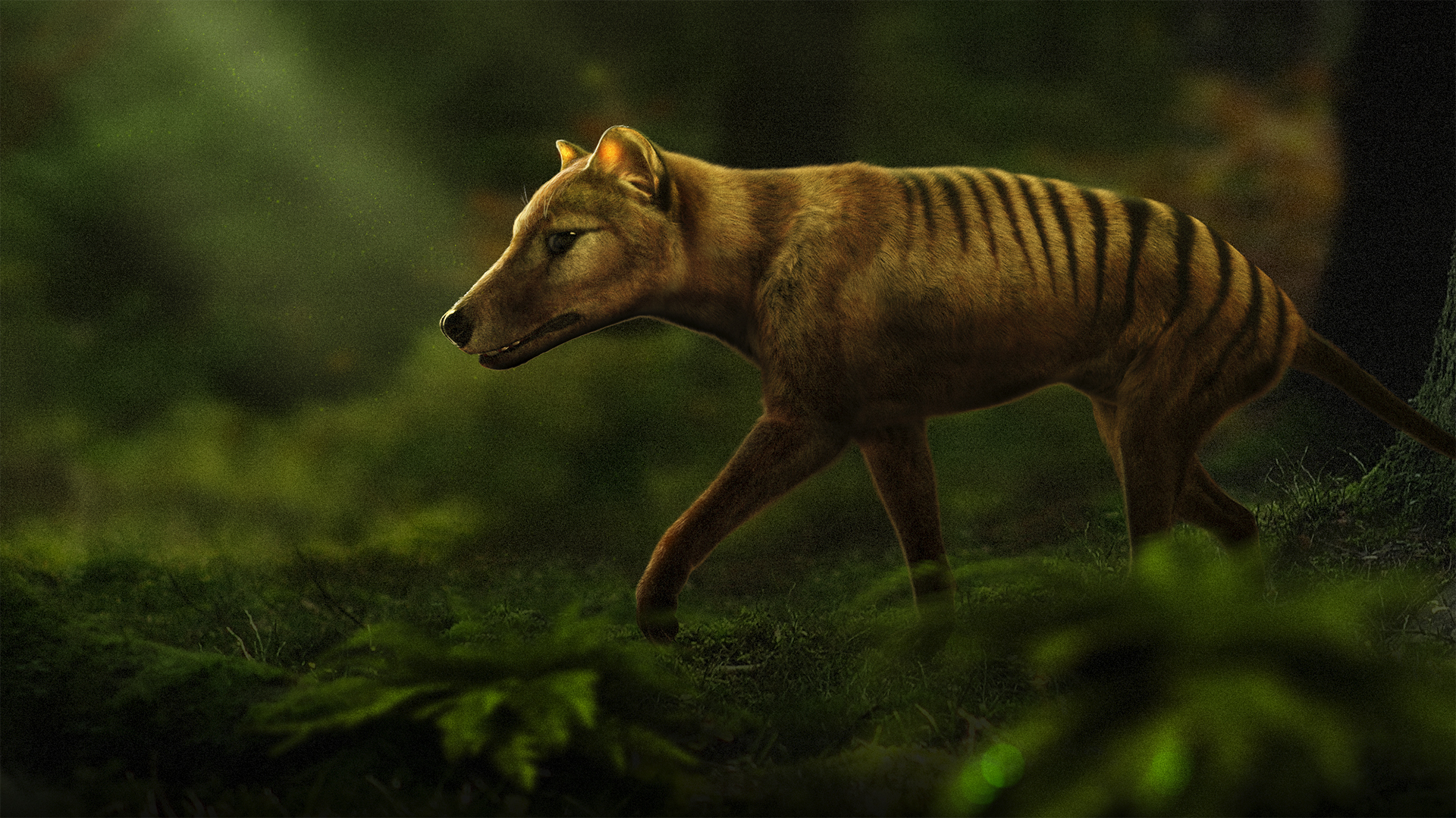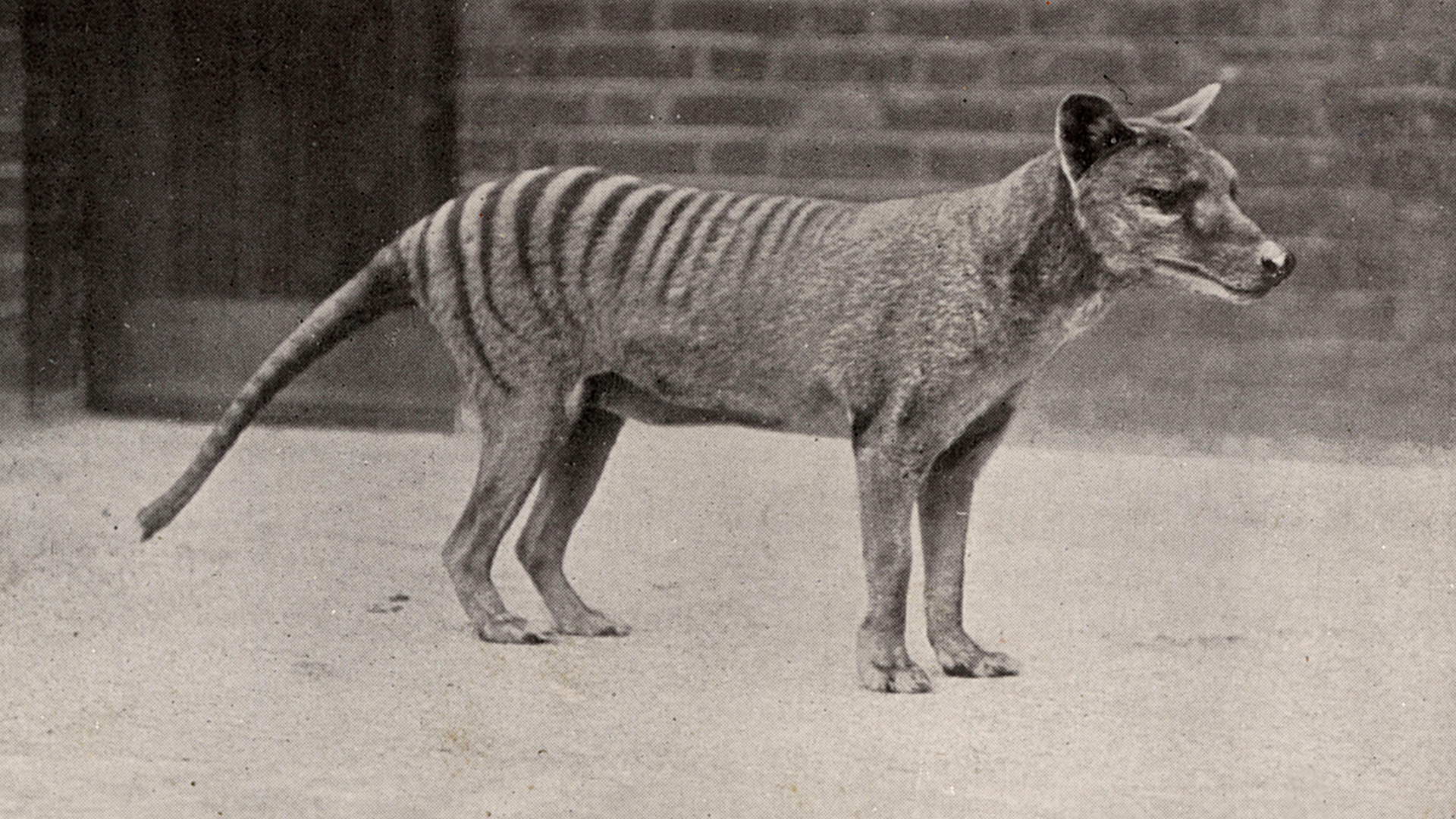Could extinct Tasmanian tigers be brought back from the dead?
The last known thylacine died in captivity in 1936.

Can an extinct species be brought back to life? Scientists are taking a "giant leap" in that direction by using gene-editing to resurrect the Tasmanian tiger, a carnivorous marsupial from Australia and the continent's only marsupial apex predator. It died out nearly a century ago, driven to extinction by human hunters and by the introduction of nonnative species to their grassland, wetland and forest habitats.
Researchers with the project, a collaboration between the University of Melbourne and the genetic engineering company Colossal Biosciences in Dallas, suggest that this so-called de-extinction could reinstall Tasmanian tigers (Thylacinus cynocephalus) to the wild within a decade, and could help restore balance to beleaguered Australian ecosystems where the animals once roamed, university representatives said in a statement.
However, such efforts also raise questions about prioritizing high-tech solutions for resurrecting charismatic animals that humans have already exterminated, while hundreds of species teeter on the brink of extinction today, The Guardian noted.
Related: Stunning colorized footage provides a glimpse of the last known Tasmanian tiger
Scientists in the Thylacine Integrated Genomic Restoration Research (TIGRR) Lab at the University of Melbourne have already sequenced the thylacine genome from preserved thylacine DNA and pinpointed which living marsupials are most genetically similar to thylacines, according to the statement. Colossal's CRISPR gene editing technology will enable the group to take cells from a closely related living marsupial species, the fat-tailed dunnart (Sminthopsis crassicaudata), create a template genome, and then edit it to produce a thylacine genome and grow viable thylacine embryos.
"With this partnership, I now believe that in ten years' time we could have our first living baby thylacine since they were hunted to extinction close to a century ago," team member Andrew Pask, a professor of epigenetics at the University of Melbourne and leader of the TIGRR Lab, said in the statement. "We can now take the giant leaps to conserve Australia's threatened marsupials and take on the grand challenge of de-extincting animals we had lost."
Tasmanian tigers, or thylacines, appeared in Australia about 4 million years ago and were once widespread across the continent, according to the Australian Museum in Sydney. Despite their name, they didn't look much like tigers; in fact, they were sometimes referred to as "long dogs with stripes" because of their doglike heads and distinctively-marked rumps, according to the University of Melbourne. Thylacines had short ears and legs, and long, rigid tails, and they were about the size of an American coyote, standing approximately 24 inches (60 centimeters) tall and weighing 37 to 44 pounds (17 to 20 kilograms), scientists reported in 2020 in the journal Proceedings of the Royal Society B: Biological Sciences.
Get the world’s most fascinating discoveries delivered straight to your inbox.
Thylacines vanished from most of the Australian mainland about 2,000 years ago, and an estimated population of about 5,000 were in Tasmania around the time of European colonization in the 1800s, according to the National Museum of Australia (NMA) in Canberra. But by the 1920s, thousands of Tasmanian tigers had been slaughtered by human hunters who mistakenly saw the marsupials as a threat to livestock. The last Tasmanian tiger seen in the wild was killed in 1930, and the last specimen in captivity — an individual nicknamed "Benjamin" — died in the Hobart Zoo in 1936, NMA says.
According to researchers with the de-extinction project, resurrecting Tasmanian tigers would be a conservation success story; not only for restoring a species lost to human activity, but also for building a lifeline for vulnerable and threatened species across Australia, "developing gestational and genetic rescue technologies for future marsupial conservation efforts," Colossal CEO and co-founder Ben Lamm said in a statement.
"With our planet's biodiversity at risk, we will continue to contribute scientific resources to preserving the species and ecosystems necessary to sustain life," Lamm said.
Originally published on Live Science.

Mindy Weisberger is a science journalist and author of "Rise of the Zombie Bugs: The Surprising Science of Parasitic Mind-Control" (Hopkins Press). She formerly edited for Scholastic and was a channel editor and senior writer for Live Science. She has reported on general science, covering climate change, paleontology, biology and space. Mindy studied film at Columbia University; prior to LS, she produced, wrote and directed media for the American Museum of Natural History in NYC. Her videos about dinosaurs, astrophysics, biodiversity and evolution appear in museums and science centers worldwide, earning awards such as the CINE Golden Eagle and the Communicator Award of Excellence. Her writing has also appeared in Scientific American, The Washington Post, How It Works Magazine and CNN.



